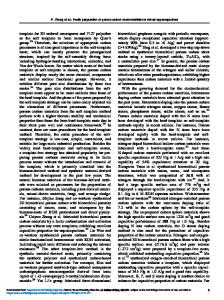Facile preparation of three-dimensional honeycomb nitrogen-doped carbon materials for supercapacitor applications
- PDF / 940,757 Bytes
- 10 Pages / 584.957 x 782.986 pts Page_size
- 3 Downloads / 341 Views
Facile preparation of three-dimensional honeycomb nitrogen-doped carbon materials for supercapacitor applications Hongjuan Zhang1, Zunli Mo1,a), Ruibin Guo1, Nijuan Liu1, Min Yan1, Ruijuan Wang1, Hangkong Feng1, Xiaojiao Wei1 1
Research Center of Gansu Military and Civilian Integration Advanced Structural Materials, College of Chemistry and Chemical Engineering, Northwest Normal University, Lanzhou 730070, China a) Address all correspondence to this author. e-mail: [email protected] Received: 28 December 2018; accepted: 15 February 2019
The preparation of three-dimensional honeycomb nitrogen-doped carbon materials (3D-HNCMs) which can be used as electrode materials for supercapacitors is reported. The composites with the 3D honeycomb structure exhibited better electrochemical performance, and the structure and properties were proved by various means, such as SEM, TEM, IR, N2 sorption, XRD and XPS. Used as electrode materials for supercapacitors in the KOH electrolyte, 3D-HNCMs displayed a significantly high specific capacitance (409 F/g at a current of 0.5 A/g). Moreover, the 3D-HNCM electrode exhibited superior electrochemical performance, such as excellent cycling stability (98% capacitance retention after 10,000 cycles), a maximum energy density of 15.37 W h/kg, a maximum power density of 40.3 kW/kg, and low equivalent series resistance (2.1 X). Particularly, the electrochemical characteristic of 3D-HNCMs could be attributed to the synergistic effect of a high surface area, unique microporous and mesoporous structure, and nitrogen atom doping. These carbon materials with unique structure are promising electrode materials for future supercapacitor application.
Introduction With the rapid growth of environmental concerns, there is a great requirement for more advanced energy storage devices with high performance [1]. As a class of promising energy storage devices, supercapacitors are one of the most interesting electrical energy storage devices because of their great advantages such as high power density, operation over a wide temperature range, no memory effect, long life cycle, and good stability [2, 3]. In recent years, carbon-based supercapacitors, as ideal energy-storage devices for fast storage and release of energy, have attracted great attention for energy management in the future electricity-powered world [4, 5]. Thus, the carbon electrode material, as the key contributor of energy storage of supercapacitors, is attracting considerable research interest in the materials science and energy storage fields [6, 7, 8]. Among the various candidates available, carbon-based materials ranging from activated carbons [9] to graphene [10] have attracted extensive attention in many energy-related applications, and are the most
ª Materials Research Society 2019
widely available electrodes due to their high surface area, good electrical conductivity, and low cost [11]. Recently, novel carbon nanomaterials, such as hierarchical porous carbon or heteratom doped carbon, have been widely applied in supercapacitor elect
Data Loading...











